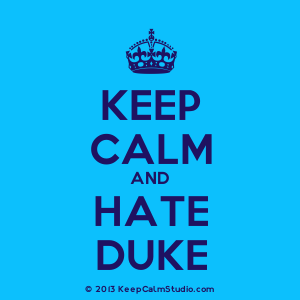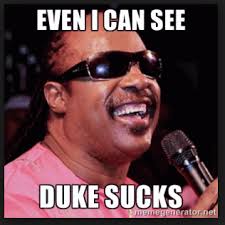Duke Sucks: The Legal Planet March Madness Special
Why Is The University Killing Light Rail In The Research Triangle?
 Like most people of intelligence and character, when it comes to NCAA basketball, I despise the Duke Blue Devils. As the precocious son of a good friend notes, “you can’t spell Blue Devil without evil.” I acknowledge
Like most people of intelligence and character, when it comes to NCAA basketball, I despise the Duke Blue Devils. As the precocious son of a good friend notes, “you can’t spell Blue Devil without evil.” I acknowledge Mr. Mxyzptlk’s Mike Krzyzewski’s greatness as a basketball coach, but it’s too much to put up with garbage quotations like this:
“I don’t look at myself as a basketball coach. I look at myself as a leader who happens to coach basketball.”
Oh please. Can I get the vomit bag now? And don’t get me started with, say, Ted Cruz look-alike Grayson Allen.
That being said, it has always been a little problematic to me. After all, Duke has an excellent reputation for its players actually going to class and graduating. Moreover, they were defeated by Michigan State, which for years employed and protected Larry Nassar.
Environmentalism to the rescue!
For years, GoTriangle, the Research Triangle’s transportation agency has been planning, and investing millions in, a projected 17.7 mile light rail line from Durham to Chapel Hill. This isn’t a basketball train: the Triangle is a remarkable region with horrible land use planning. Better transit would allow the region to begin to develop in a reasonable, environmentally-friendly way, helping people avoid brutal commutes on the I-40, and helping to preserve much of the area’s natural beauty.
All this came to a screeching halt on February 27, when Duke University officials said they would not sign a cooperative agreement. (The project required 11 partners to ink cooperative agreements; only Duke, Norfolk Southern, and the North Carolina Railroad Company, which manages a major rail corridor, remain unsigned.) A week later, Duke declined a request to participate in a mediated negotiation with GoTriangle, the region’s transportation authority.
Duke’s bombshell is likely to spell the end of the line for the project.
 This is crucial because the light rail was supposed to run through parts of Duke’s campus. The University has yet to give any reasonable explanation for its position. All of a sudden, it raised concerns that it had had years to raise before; indeed, “in 2016, Duke officials signed a non-binding memorandum of understanding to cooperate with GoTriangle. Duke raised no issues about the route during the environmental impact comment period in 2015 and 2016.” It didn’t raise issues about the magnetic rail, allegedly a problem for its hospital, until 2017. GoTriangle’s repeated attempts at compromise were met with a spiteful stomp that would have done Christian Laettner proud.
This is crucial because the light rail was supposed to run through parts of Duke’s campus. The University has yet to give any reasonable explanation for its position. All of a sudden, it raised concerns that it had had years to raise before; indeed, “in 2016, Duke officials signed a non-binding memorandum of understanding to cooperate with GoTriangle. Duke raised no issues about the route during the environmental impact comment period in 2015 and 2016.” It didn’t raise issues about the magnetic rail, allegedly a problem for its hospital, until 2017. GoTriangle’s repeated attempts at compromise were met with a spiteful stomp that would have done Christian Laettner proud.Reader Comments
4 Replies to “Duke Sucks: The Legal Planet March Madness Special”
Comments are closed.






Anyone of true intelligence and character knows that the Blue Devils are despised (by the weak) because they are great. And they are great because Mike Krzyzewski (who happens to be their coach) is a great leader. As another great college basketball coach, John Wooden, once said “In the end, it’s about the teaching, and what I always loved about coaching was the practices. Not the games, not the tournaments, not the alumni stuff. But teaching the players during practice was what coaching was all about to me.”
Anyone of true intelligence and character also knows that Duke did not kill the DOLT (or DOLRT) light rail project that would connect Chapel Hill to Durham (but not Raleigh). In fact, Duke has proposed solutions to its concerns regarding electromagnetic interference, vibrations, power disruption and liability (such as altering the route by one block and indemnification against harm caused by the rail line), but no agreement has been reached and its concerns remain unresolved.
Moreover, the projected cost for the DOLT now exceeds $3 billion and will not be fully paid until 2060. Federal and state funding, were originally expected to fund 75 percent of the project, but has dropped sharply. And the original vision 30 years ago of a convenient network of light rail lines throughout the Research Triangle has been reduced to a single line that would take nearly an hour to go from Chapel Hill to Durham, and won’t go anywhere near Research Triangle Park or Raleigh-Durham International airport. In fact, the original main line from Raleigh to Durham was canceled in 2006 when the Federal Transit Administration refused to fund it.
Duke has raised objections to a rail line that would run adjacent to its hospital for the past 20 years. Its concerns weigh even greater now as the benefits of the DOLT decline. While Duke remains open to discussion, it bears responsibility for its own community. In doing so, Duke is following the advice of Coach Wooden, “You can’t let praise or criticism get to you. It’s a weakness to get caught up in either one.”
You have a bright future in university public relations. Duke signed an MOU in 2016 saying that it was willing to move ahead and keep talking, and then suddenly backed away. I’m not buying.
And there is a massive difference between John Wooden saying he likes, as a coach, to be a teacher, and Mr. Mxyzptlk claiming that he is only incidentally a basketball coach.
But I respect your loyalty to your alma mater!
This reminds me again that it may be time to rethink the basic paradigm of “light rail”. Conventional rail is designed to carry heavy goods, not very light objects like people and the basic concept dates back to the beginning of the 1800’s (and even Roman legion chariots). An optimized design of a vehicle that carries a very light good that is self-mobile (doesn’t have to be unloaded) is probably not the same as a railroad and we have a lot of much more lightweight materials to use for this. Note for example that just the track foundation and ballast required for dual rail systems is not trivial in cost or environmental impact.
I have done some “back of the spreadsheet” calculations on an overhead single rail system with aircraft level lightweighted aluminum or advanced composite vehicles that suggest that this might be a reasonable alternative, but this is something that needs to be studied with an open mind.
My. What a classy blog from UCLA and Berkeley Law. When you don’t have the facts, pound the table?
Mr. Zazloff appears to be avoiding any response to the substantive issues raised by Mr. Rho. Can you please provide your rebuttal?